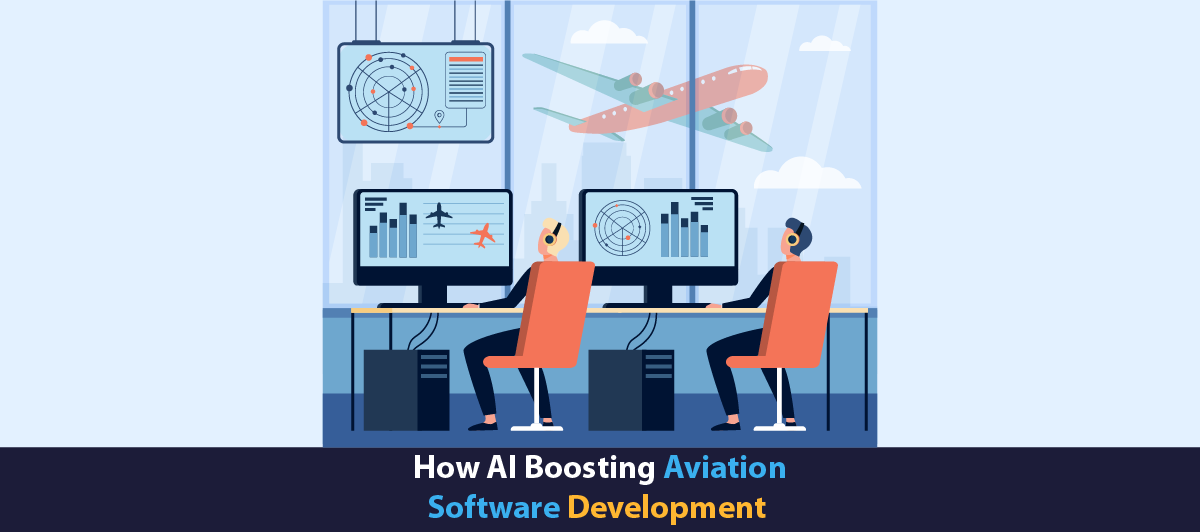How Aviation Software Development Boosting With AI
Quick Summary: The integration of AI technologies is driving the development of aviation software by leaps and bounds. The power of artificial intelligence makes aircraft software systems smarter, more efficient and safer. AI enables predictive maintenance, real-time data analysis, and improved decision-making capabilities for aircraft manufacturers. Read more about its benefits!
Introduction
The integration of artificial intelligence (AI) has revolutionized aviation software development ai in aviation itself. From enhancing safety measures to improving operational efficiencies, AI is revolutionizing aviation software design, operations and operations.
But how?
So, we will disclose various ways in which AI is driving innovation in the aviation industry.
One of the most important areas where AI is making its mark is in predictive maintenance. By analyzing vast amounts of data collected from aircraft sensors and systems, AI algorithms can predict potential equipment failures. Which allows airlines to more aggressively manage maintenance issues,. Additionally, it reduces downtime cost-effective operations and even, AI-controlled analysis customer data to design more efficient flight plans. Weather, air traffic congestion , considering factors such as fuel efficiency and flight design and strategy of facilitating efficiency.
In addition, AI is revolutionizing pilot training programs through advanced computer vision and simulation tools and personalized learning experiences. Using virtual reality and machine learning algorithms, pilots can hone their skills in real environments, and receive personalized feedback to improve performance. It increases the possibilities for innovation and improvement are limitless, promising an air-conditioned future. Transportation Is safer, more efficient and more accessible than ever before.
Get more in-depth knowledge on how AI is transforming software development for the airline industry.
Overview To Aviation Software Development
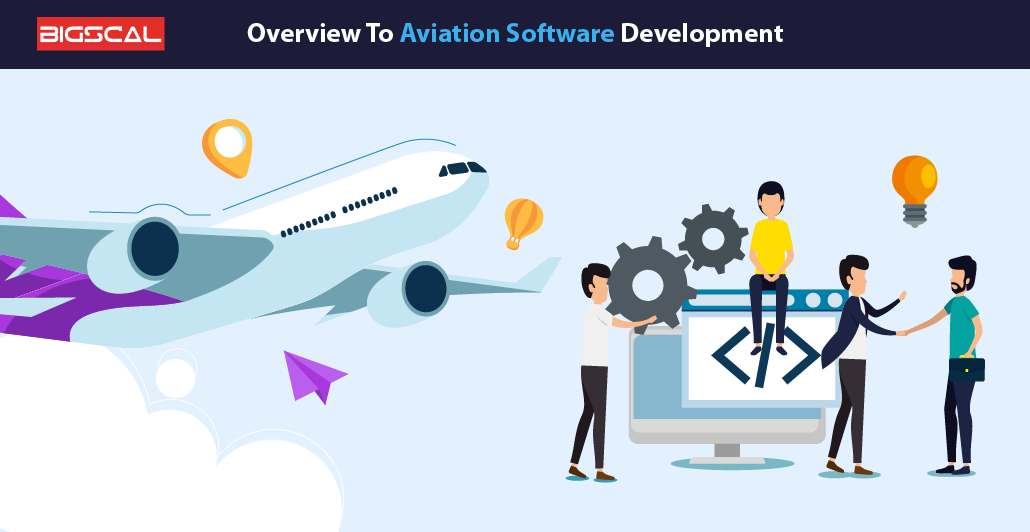
Aviation Software Development Companies involves the development, implementation, and maintenance employ ai amount of software systems tailored to the specific needs of the aviation industry. These systems cover flight planning, navigation, weather control, aircraft maintenance, passenger control, and air traffic control. Developers of this facility must meet strict safety and regulatory standards by aviation authorities. These are the Federal Aviation Administration (FAA) and the European Aviation Safety Establishment Agency (EASA).
Key considerations in flight software development include real-time data processing, fault tolerance, redundancy, and interoperability with existing systems. Developers typically use programming languages such as C++, Java, and Python, as well as specialized tools and frameworks for simulation, modeling, and testing. The ultimate goal is to ensure the reliability, efficiency and safety of airport operations and the airline industry. Additionally, it also aims and to make the development of aircraft software an essential part of modern air traffic management.
Types Of Aviation Software
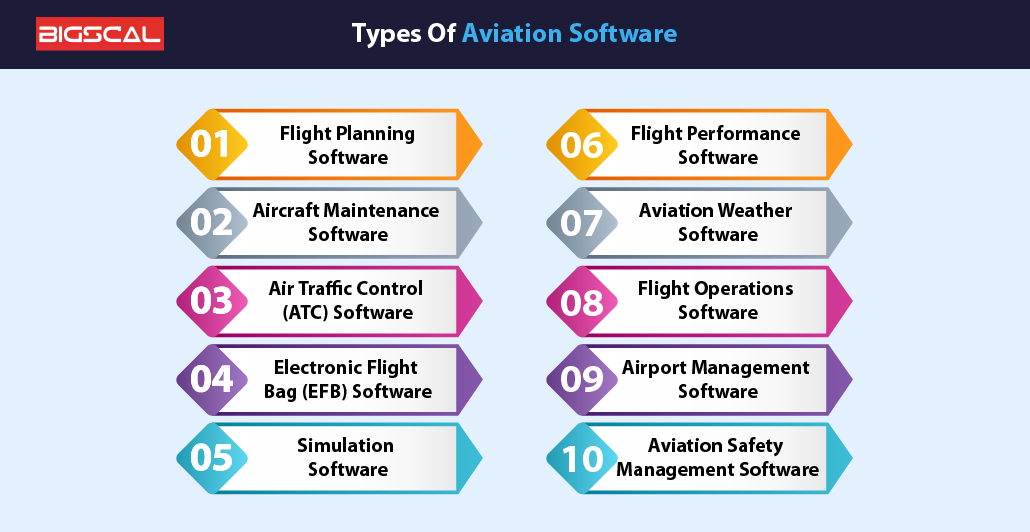
Flight planning software
Helps pilots plan routes, calculate fuel requirements, and assess weather conditions for safe and efficient flying.
Aircraft Maintenance Software
Manages maintenance costs, schedules, records and services for individual aircraft, ensuring they remain airworthy and compliant.
Air Traffic Control (ATC) Software
Facilitates communication historical data, and coordination between air traffic controllers and pilots, enabling air traffic to operate safely and orderly.
Electronic Flight Bag (EFB) Software
Provides pilots with digital access to charts, manuals, weather information, and other important documents during flight.
Simulation software
Pilot training simulators train pilots in a variety of scenarios and techniques by simulating real-world flight situations.
Flight Performance Software
Calculates flight performance indicators such as take-off and landing, climb rate and fuel consumption. This is based on various factors such as weight, altitude and weather conditions.
Aviation Weather Software
Provides pilots and shippers with real-time weather information, forecasts and alerts to assist in flight planning and decision making.
Flight Operations Software
Manages aspects of airline operations, including crew scheduling, flight planning, and passenger scheduling.
Airport Management Software
Supports airport efficiency by managing features such as gates, runways and ground handling.
Aviation Safety Management Software
Monitors and analyzes safety data to identify trends, mitigate risks, and improve overall safety in the aviation industry.
Quick Overview Of Artificial Intelligence In Aviation Industry
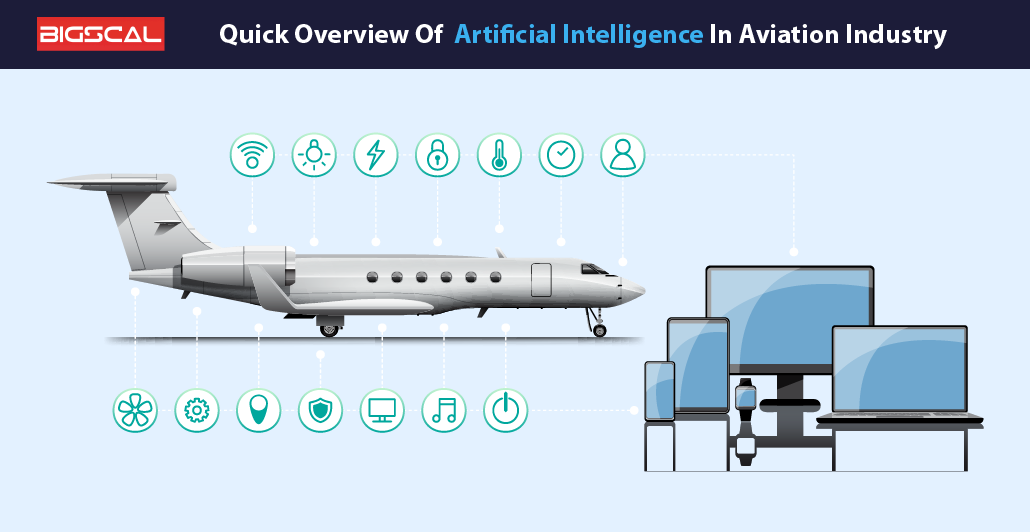
Integration of artificial intelligence in aviation is transforming the airline industry by improving safety, efficiency and passenger experience. AI in aircraft maintenance analyzes large amounts of data to predict mechanical failures in advance, reducing downtime and costs. AI systems optimize flight paths based on weather, fuel efficiency and control over congested weather conditions. It is to improve timely performance and reduce emissions and reduce flight delays.
In air traffic control, AI algorithms help controllers control and direct flights, improve traffic flow, and reduce delays. Travel services could benefit from AI-powered chatbots and virtual assistants. They provide personalized travel recommendations, manage bookings and provide real-time assistance.
Additionally, AI is transforming cockpit operations with features. These features are autopilot systems and predictive maintenance alerts to enhance pilot decision making and safety. Overall in flight maximize efficiency, safety, through AI data-driven insights automation. It is also reshaping the air travel industry by increasing passenger satisfaction.
How Aviation Software Development Is Boosting With AI
Here are AI software and major benefits that the aviation industry gets with the integration of AI technology in aviation software development. Read it on!
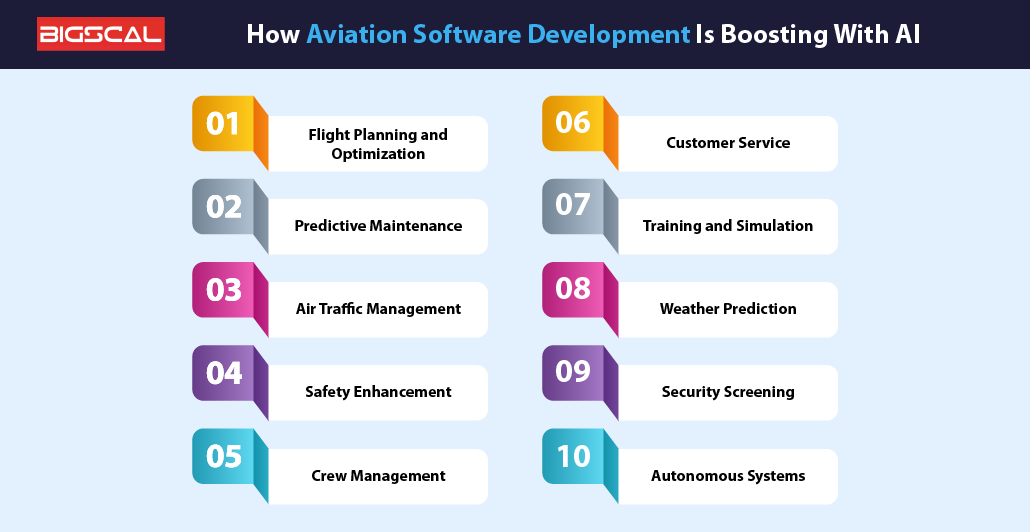
Flight Planning and Optimization
AI-powered flight software has revolutionized the design and efficiency of flights. By integrating AI systems such as machine learning and neural networks into flight planning systems. With it airlines can process a wealth of data including weather, air traffic, aircraft performance and fuel consumption research to develop more efficient and cost-effective flight paths.
These AI-organizational systems can include in real-time, weather changes, aircraft-carriers, etc. through a multidisciplinary perspective of emissions. It reduces fuel consumption, reduce emissions, uptime and provides extra work. Moreover, AI-powered flight planning and optimization software plays an important role in increasing the airline’s efficiency. It reduces costs and the environment they encounter.
Predictive Maintenance
Aircraft software powered by AI is changing predictive maintenance practices in the industry. By analyzing data collected from aircraft sensors, historical maintenance records, and component performance. AI algorithms can predict potential equipment failures in advance. This early adoption approach helps airlines optimize schedule maintenance schedules, reducing unscheduled downtime and operational disruptions.
Additionally, the AI is able to identify patterns and anomalies in the data to identify early signs of damage. It allows maintenance personnel to address issues quickly, and increasing the reliability and safety of the aircraft AI is a great deal.
Air Traffic Management
Aircraft software development has been greatly enhanced by the integration of AI into air traffic control. AI algorithms are transforming air traffic controllers to meet today’s aviation businesses challenges. By analyzing multiple sources of data such as radar, weather forecasting and flight planning. AI systems can fill in potential jam areas, optimize roads and suggest new routes in real time. Thus, reducing delays, reducing fuel consumption and increasing productivity.
Moreover, AI-powered flight control systems can automate routine tasks, allowing controllers to focus on more important decisions. For example, AI can help identify potential conflicts between aircraft and propose solutions. Thus, increasing safety and reducing the workload of maintenance personnel. In addition, generative AI algorithms can continuously learn and adjust to changing transportation schedules and environmental conditions to maximize air traffic control. It is responsive and tireless. It enhances aircraft and ground operations.
Safety Enhancement
The integration of AI into aircraft software development has dramatically improved safety. AI is able to analyze vast amounts of data and identify patterns and trends that can indicate potential security risks. For example, AI algorithms can analyze aircraft performance data to identify abnormalities or predict mechanical failures. It enables faster repair actions to prevent accidents.
Additionally, AI-powered safety management systems can analyze incident reports, maintenance logs and flight data to identify safety issues and potential hazards. This approach allows aviation authorities and airlines to implement targeted safety measures and preventative actions to effectively mitigate risk.
In addition, AI can enhance safety through predictive analytics by providing contributing factors to safety issues. These are weather, aircraft density, pilot fatigue and real-time detection and predictive alerts To the highest level of Kana and staff You can ensure safety.
Crew Management
AI has greatly advanced the development of aviation software, especially in the area of flight crew management. AI algorithms analyze large amounts of data including crew schedules, flight plans and crew preferences to optimize crew planning and scheduling. By incorporating AI, airlines can ensure efficient crew utilization. It reduces disruption due to unforeseen circumstances such as weather delays or unavailability of flight attendants. You can, regulators such as rest periods and certificates can comply with the requirements.
Additionally, AI-powered crew management systems can predict future crew needs based on historical data and real-time fluctuations. It allows airlines to proactively address potential shortages or surpluses use. This predictive capability enables better workforce planning and resource allocation, ultimately resulting in cost savings and improved operational efficiencies.
Customer Service
AI has revolutionized customer service in airline software development by providing personalized and efficient communication throughout the passenger journey. AI-powered chatbots and virtual assistants are being deployed on airline websites and mobile apps. It is to provide immediate answers to customer queries. It may be booking assistance, flight status updates and baggage claims that pass through the information.
These AI systems use natural language processing (NLP) and machine learning algorithms to better understand and answer various customer queries. By automating routine tasks and inquiries, airlines can free up human representatives to manage complex issues. It also speeds up resolution times and provides customers great satisfaction.
Additionally, AI-enabled analytics tools analyze customer responses and behaviors to identify areas for service improvement and personalize marketing campaigns, ultimately driving stronger customer loyalty and income opportunities increase.
Training and Simulation
The integration of AI into training and simulation systems has greatly advanced the development of aircraft software. AI algorithms are transforming pilot training by providing more realistic dynamic scenarios in simulated environments. These systems can simulate flight situations, malfunctions, and emergencies. It allows pilots to learn and refine their skills in a safe and controlled environment. Using machine learning, these simulators can adjust and adjust based on pilot performance, creating a personalized training experience.
Additionally, AI-powered training software is able to analyze vast amounts of flight data to predict flight conditions and trends, enabling more effective training programs. This data-driven approach helps instructors training modules designed to address specific weaknesses or areas in individual pilots.
Weather Prediction
AI is revolutionizing weather forecasting in aviation software development by increasing forecast accuracy and reliability. Traditional climate prediction models are based on complex mathematical equations and climate data. But AI algorithms, especially machine learning models, can analyze large amounts of historical weather data to identify patterns and accurately predict future conditions
Using AI, aviation software developers can develop predictive models that consider multiple variables, such as temperature, humidity, wind speed and atmospheric pressure to make more accurate predictions These models can also factor in time real internal data from sensors, satellites and other sources It is will be possible
Also, AI-powered weather forecasting software can improve route planning and fuel efficiency by optimizing flight routes to reduce the impact of adverse weather conditions thus reducing flights operating costs of operating units to increase passenger safety and comfort.
Security Screening
In the aviation security sector, AI-powered software is changing the way passengers and baggage are screened at airports. Traditional methods based on manual inspection and metal detectors are being complemented by AI-powered solutions. Through machine learning algorithms, these systems analyze a wealth of data including passenger profiles, travel patterns and even behavioral indicators to accurately and efficiently identify potential threats
Moreover, AI enables security professionals to stay ahead of evolving threats by constantly learning from new data and adapting their algorithms accordingly This flexibility is especially important for emerging security threats is needed to stay one step ahead of pessimists. Furthermore, AI-powered safety analytics systems can reduce false alarms, enhancing the overall passenger experience, while maintaining strict safety standards
By integrating AI into security screening systems, airports can streamline operations, reduce human error, and allocate resources more efficiently. Ultimately, this provides advanced safety measures that are more reliable and less intrusive, contributing to a safer and more efficient flying environment.
Autonomous Systems
The emergence of autonomous systems in aviation software development heralds a new era of efficient and safe flying. The AI-powered technology enables the automation of a variety of flight operations, from take-off and landing to navigation and optimization. Using real-time data and sophisticated systems will allow the autonomous system to make decisions in two seconds, optimize flight paths, avoid accidents and improve fuel efficiency
Furthermore, enabling systems hold the promise of reducing human error, a major cause of flight issues. By using AI to assist or even overlay certain in-flight tasks, pilots can focus more on high-level decision making and critical situations, enhancing overall flight safety and responsive systems its ability to improve weather control, reduce congestion, and ultimately, reliable and on-time flights
But integrating systems also has challenges, including legal barriers, technical limitations, and concerns about human oversight and engagement, so ongoing research and collaboration between industry partnerships and regulation between groups is essential to realize the full capabilities of independent systems and to ensure safety and reliability in flight.
Leverage Bigscal Technologies Expertise For Aviation Software Development With AI
At Bigscal Technologies, our passion for flight software development is matched by our commitment to innovation and excellence. With our expertise in AI technology, we are poised to revolutionize the aviation industry with state-of-the-art software solutions tailored to the unique needs of airlines, airports and aviation professionals around the world.
We Harnessing the power of artificial intelligence to streamline airline operations, improve fuel efficiency, and enhance the passenger experience. With Bigscal at the helm, this vision becomes a reality. Our talented team of product developers and data scientists work tirelessly to push the boundaries of what’s possible. They use AI algorithms to analyze large amounts of data and discover actionable insights.
From predictive maintenance systems to intelligent route planning software, we specialize in customized solutions that empower airlines to increase efficiency, safety and profitability with Bigscal Technologies as our partner in the skies is a limit to innovation in flight software development.
Conclusion
The integration of artificial intelligence (AI) into aircraft software development represents a shift towards advancing safety, efficiency and innovation. In the industry the use of AI algorithms capabilities enables aircraft software search capabilities lots of data in real time. To enhance manufacturing capabilities, AI-driven systems facilitate the automation of routine tasks. It allows human resources to focus on flight operations complex and strategic parts of the process.
This collaboration between AI and flight software not only simplifies systems but also increases overall system reliability and flexibility. According to the A.I. For stakeholders, the adoption of these interconnected technologies is paramount to remain competitive, sustainable innovation. It also ensure global aviation will remain safe and effective.
FAQ
Does AI Increases customer satisfaction?
AI can increase customer satisfaction by providing a more personalized experience, improving response time, anticipating needs, and delivering more effective solutions, ultimately leading to customer satisfaction and loyalty a high yield.
How will AI be used in aviation?
In aviation, AI can optimize runways, enhance safety through predictive maintenance, improve flight management, streamline passenger operations with chatbots, and create autonomous flights for businesses various types
What are the benefits of artificial intelligence in the airline industry?
In the airline industry, artificial intelligence can improve safety, increase operational efficiency, improve resource efficiency, improve passenger experiences through personalization, and reduce costs through predictive maintenance and fuel efficiency
What is international air transport association?
The International Air Transport Association (IATA) is the trade association representing airlines worldwide. It sets industry standards, facilitates collaboration, and advocates for policies that promote safe, secure and sustainable air travel.
Can we use AI in aircraft and ground operations?
Yes, AI can be used in air and ground operations. It can optimize flight paths, help scheduling aircraft maintenance, manage air traffic, improve infrastructure, and improve overall efficiency.
